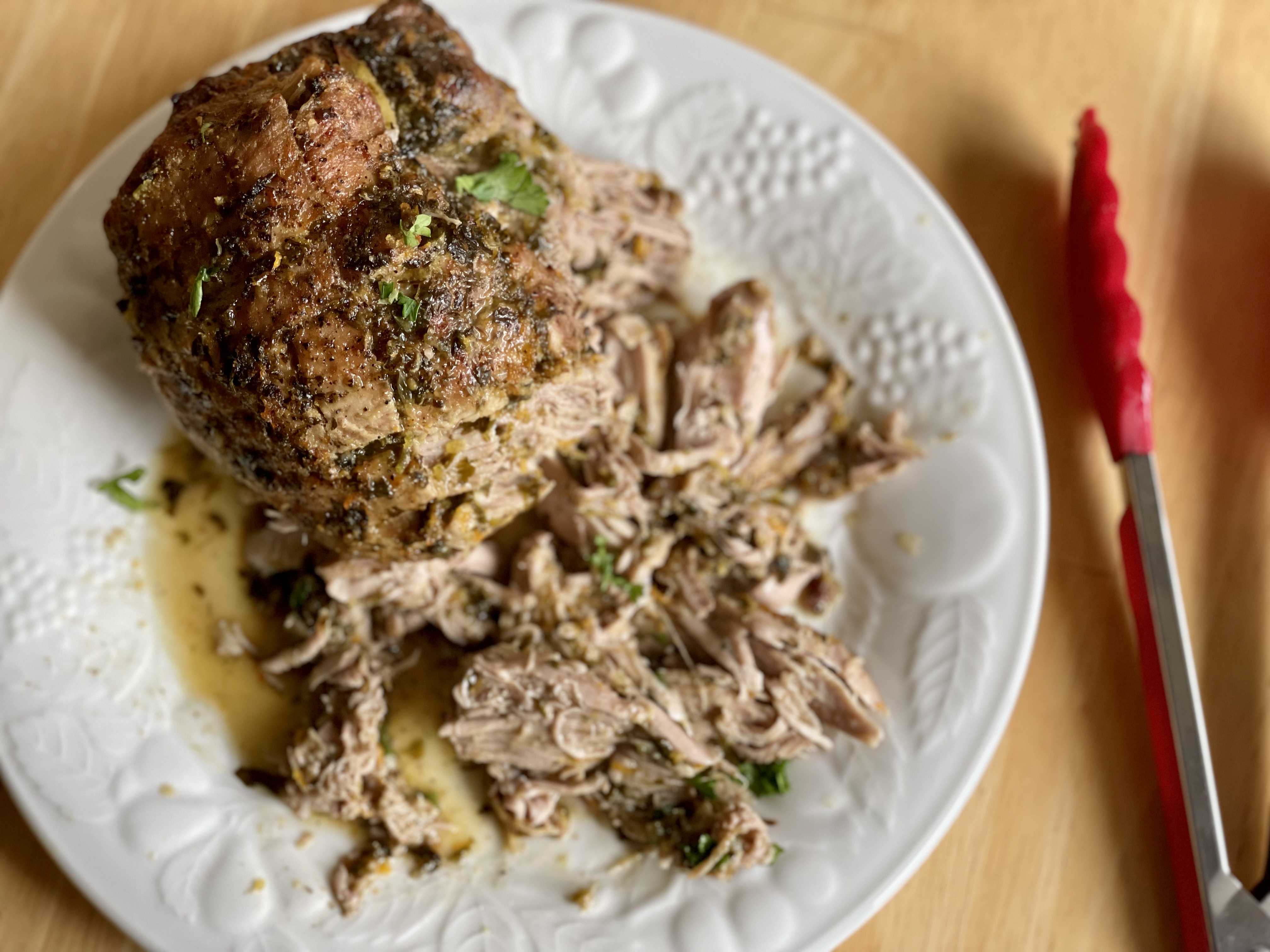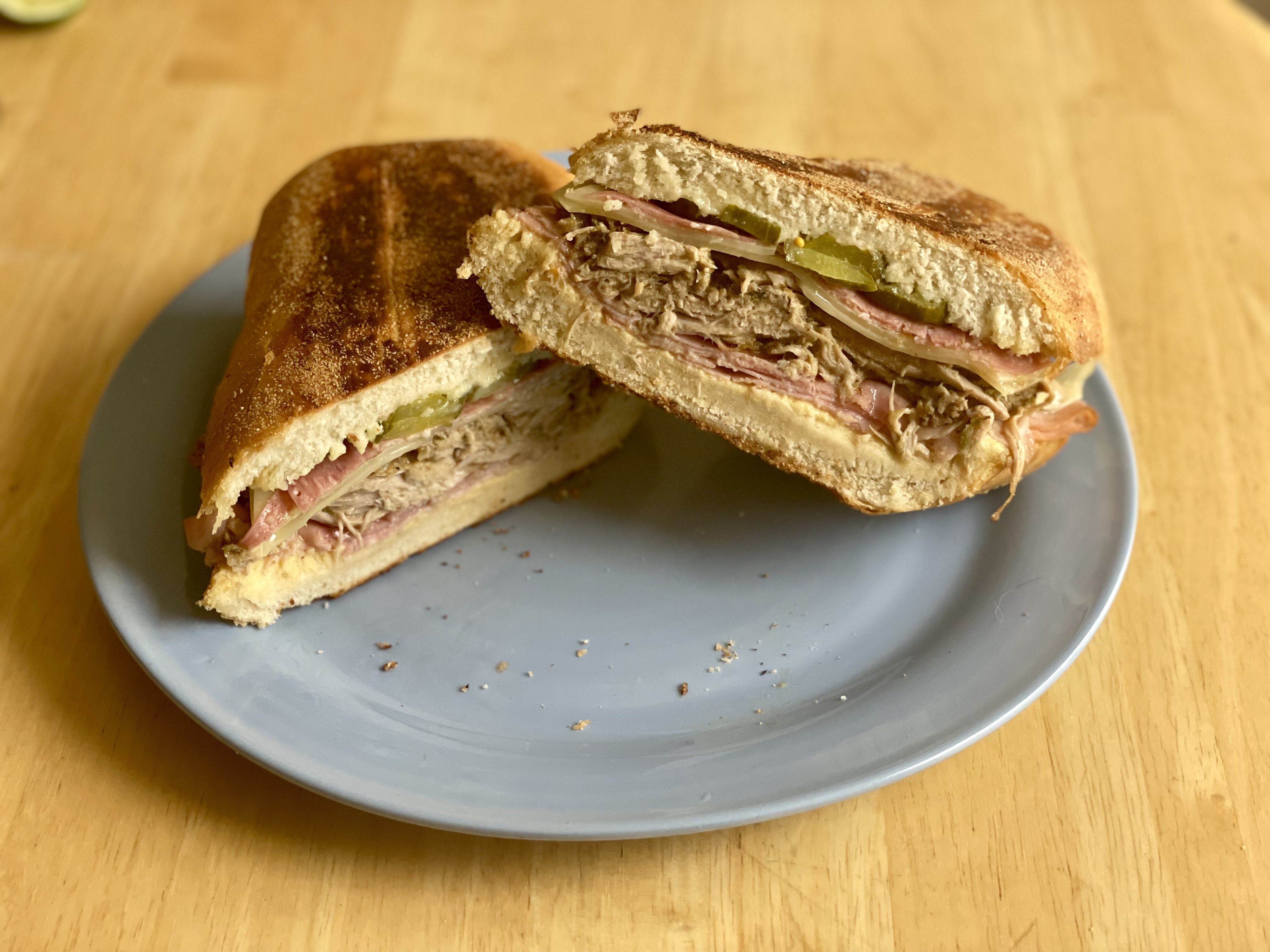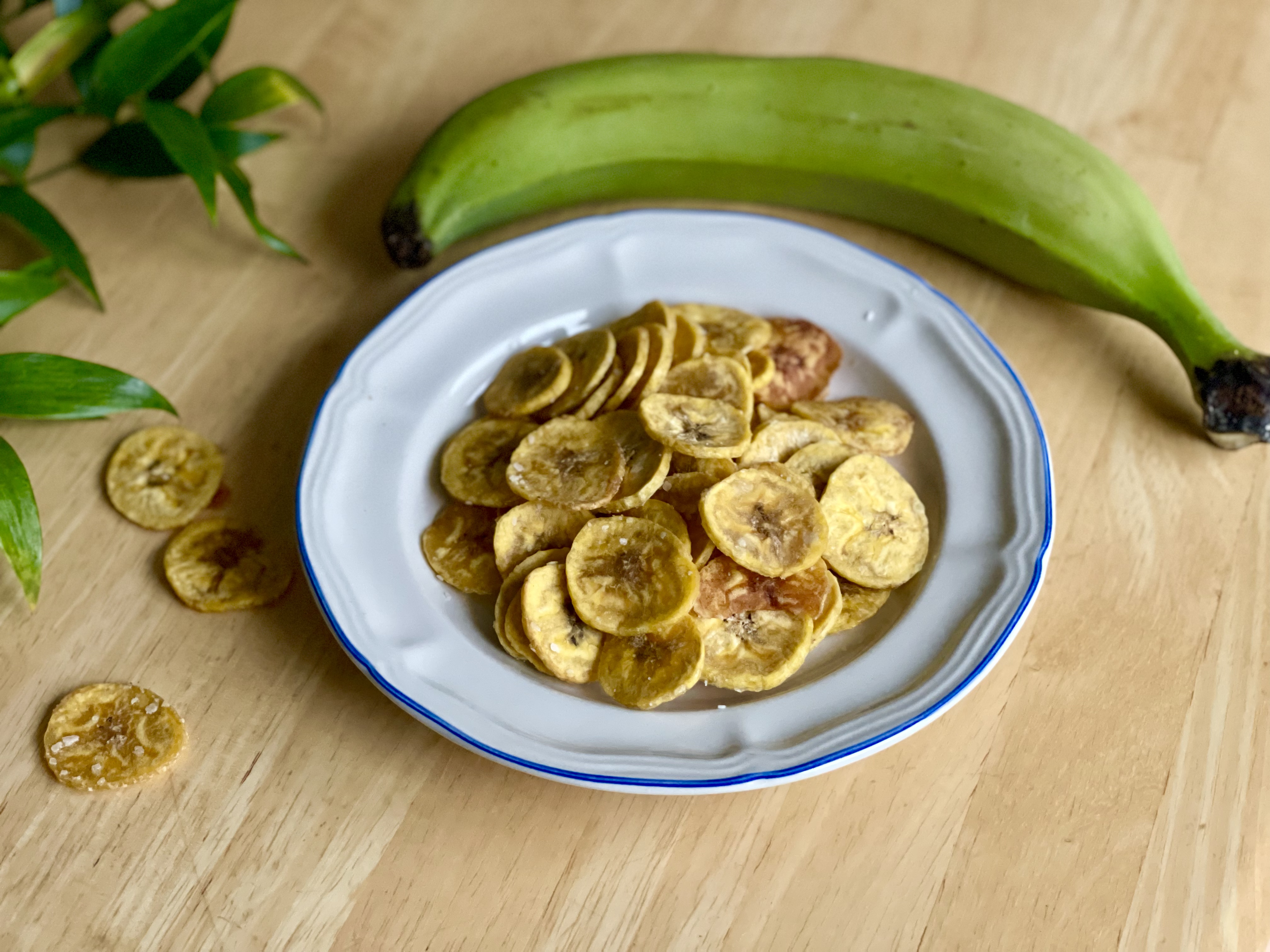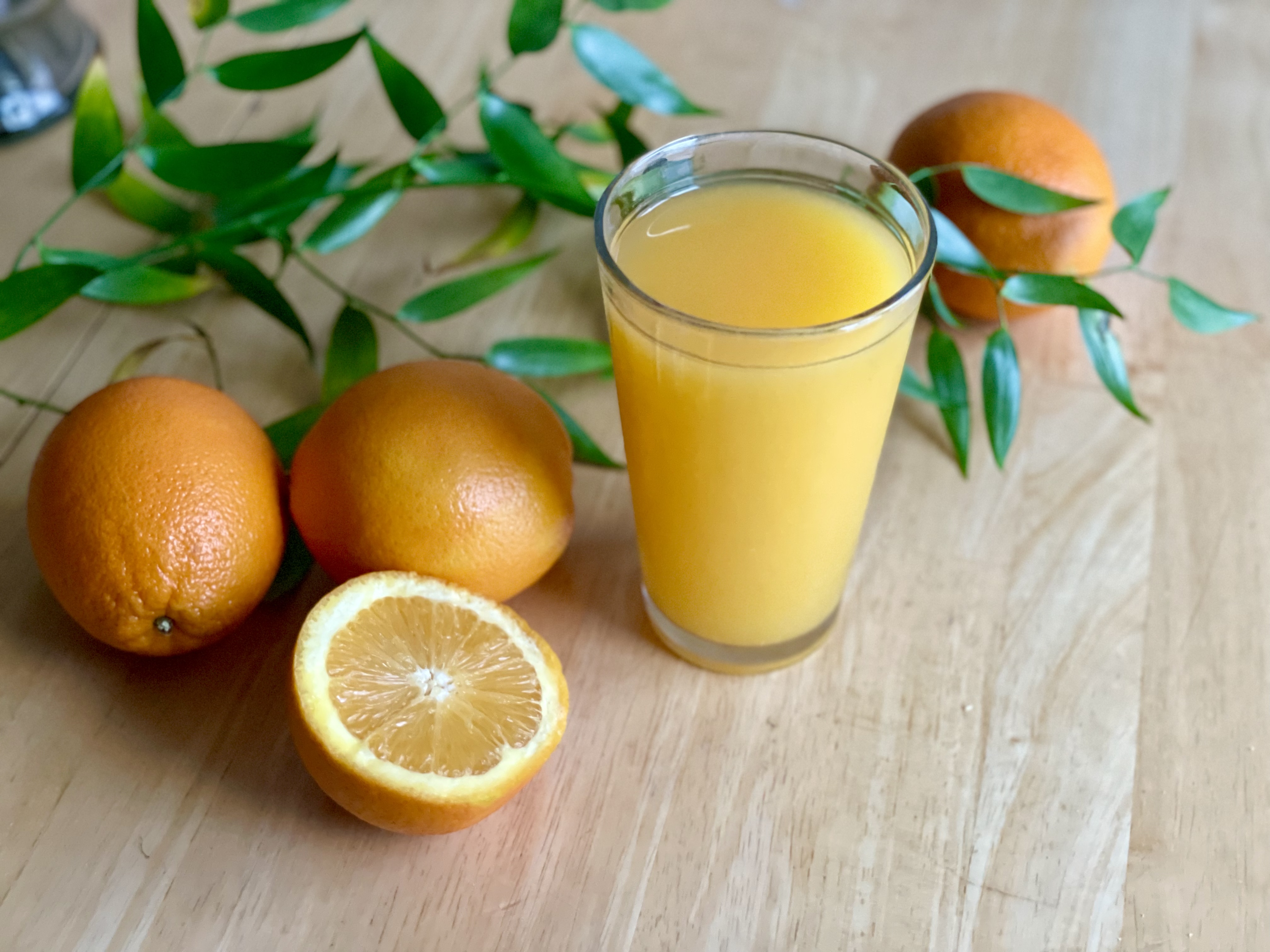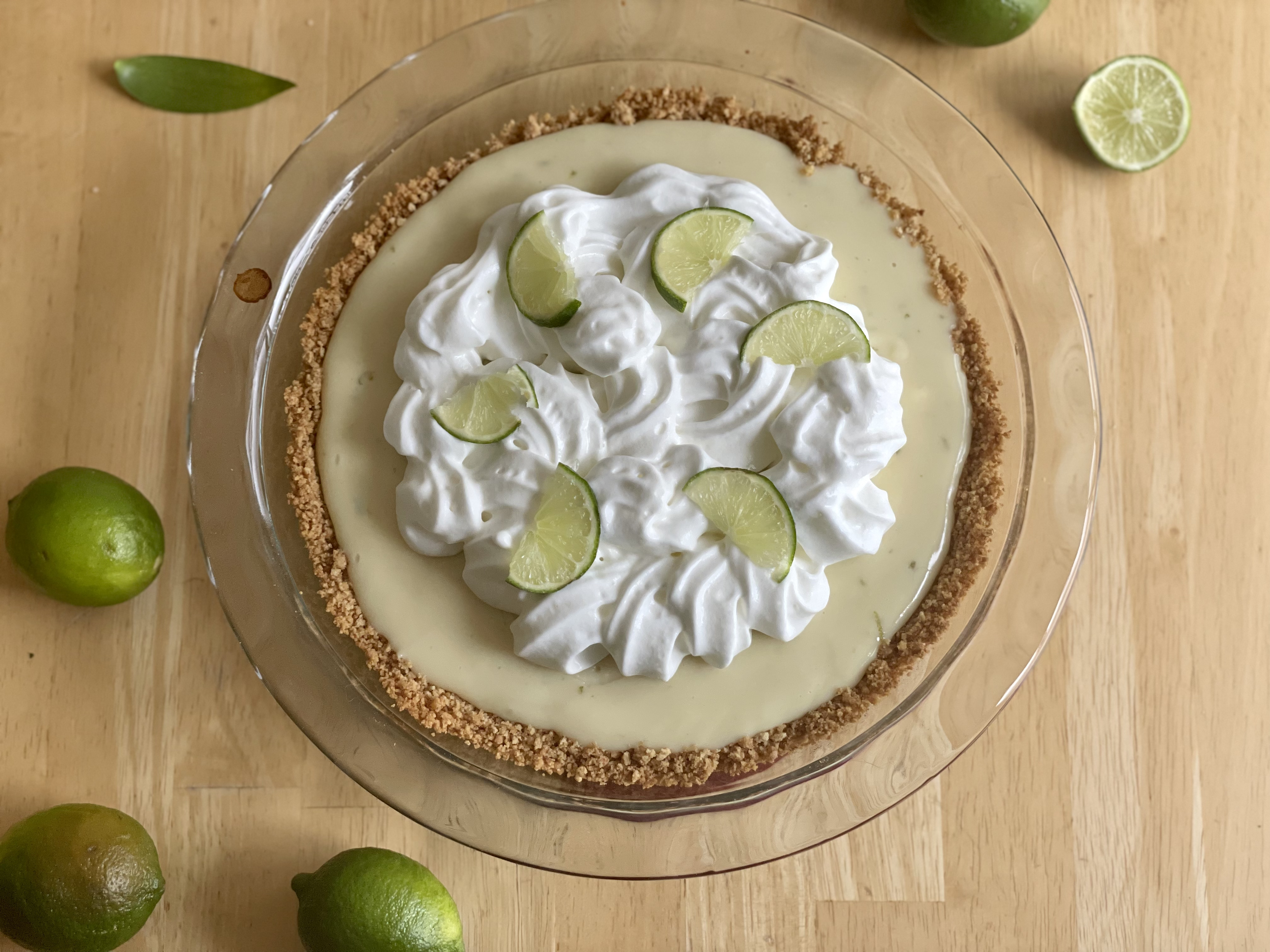Inspired by Florida
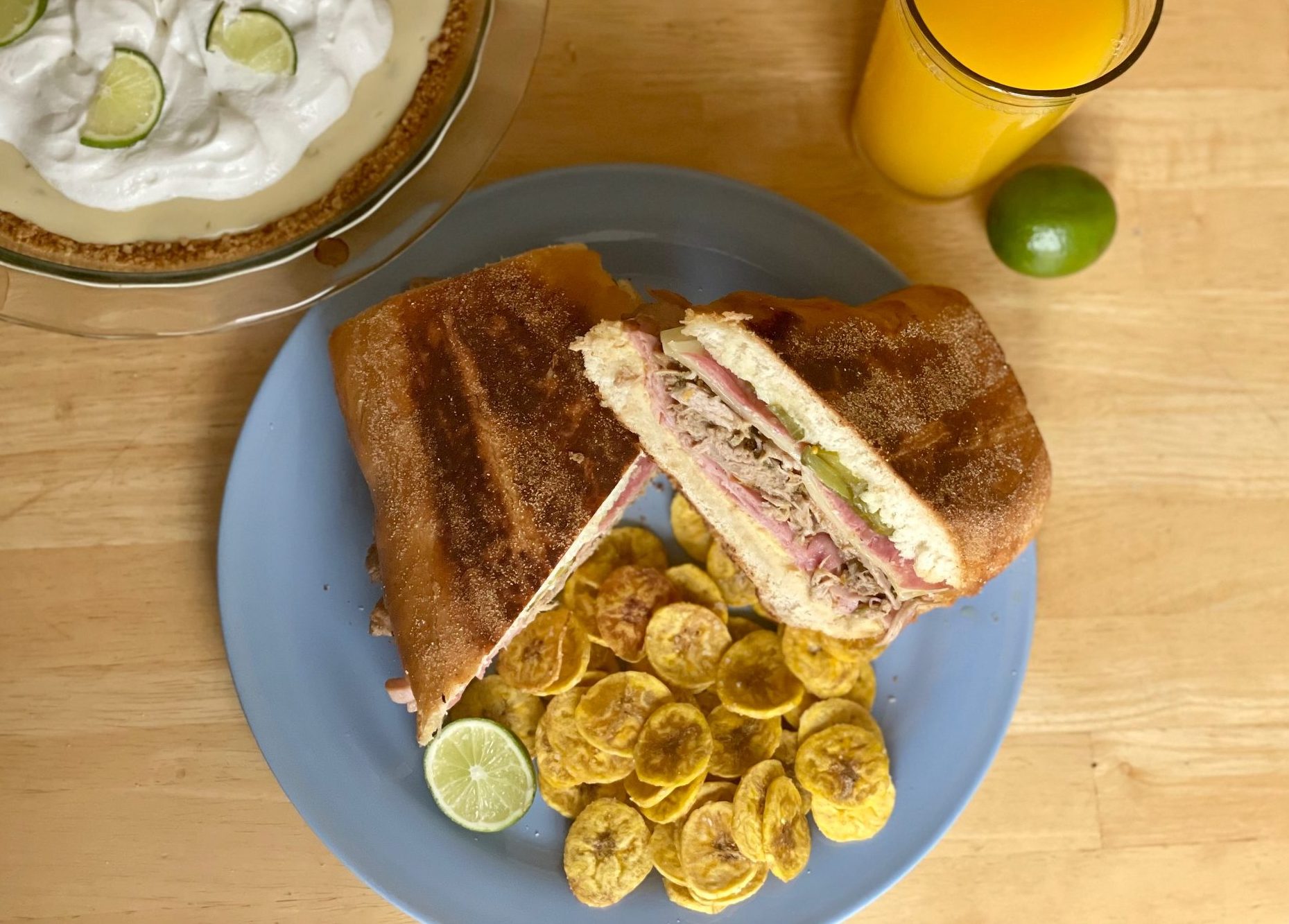
THE MEAL
(Click on the links above to jump to that part of the post!)
It’s beginning to look a lot like Christmas all around me, but this past weekend, I was in a tropical paradise cooking with lots of oranges and limes to make a fantastic summery meal.
The Sunshine State is the third-most populated state in the U.S. thanks to the attraction of its warm climate and sandy beaches. People flock there from around the world. They say 1,000 people move there every day, and Florida cuisine reflects the melting pot of cultures found there.
MOJO PORK
First up, we have Cuban-style mojo pork! “Mojo” comes from the Portuguese word for “sauce,” and several different cultures have their own kind of mojo. The Cuban-style marinade was brought to the Caribbean by the Spanish, who got it from the Canary Islands on the West Coast of Africa. The key ingredient in Cuban mojo is juice from sour oranges. Along with garlic, oregano, and other herbs, it makes the pork tart and flavorful, perfect for Cubano sandwiches!
Since I didn’t have sour oranges on hand, I found a recipe that combines regular orange juice and lime juice to make it a little more sour. I marinated the pork overnight, then slow roasted it in a Dutch oven for several hours. It turned out so tender and flavorful! I loved it on the cubano sandwich but also ate it with mashed potatoes later in the week, and I bet it would be great with rice, too!
CUBAN BREAD
For a “true” cubano sandwich, I had to make “real” Cuban bread, right? I probably could’ve gotten away with just using French bread, but I love any excuse to make bread, and I really need the practice.
Cuban bread originated in Yber City, Florida, which has a vibrant Cuban-Spanish-Italian community. The bread is pretty similar in method to French bread, but it has a denser crumb and uses fat, giving it a light, buttery flavor. But what really sets Cuban bread apart is the baking method. Traditionally, Cuban bread is baked with a palmetto leaf on top, which scores the bread as it bakes, giving it its distinctive stripe down the middle. La Segunda Bakery in Tampa has been making Cuban bread since 1915, with the original Italian baker passing down the method to his descendants, who make it today! It’s considered an essential bread for making authentic Cubano sandwiches, and leftover stale bread is a key ingredient in another Florida delicacy–deviled crab.
Making this bread was pretty simple. I think I’m getting a better feel for when bread dough has been kneaded enough and when it’s baked perfectly. However, my shaping and scoring skills still need work. My loaf was pretty lumpy and crooked. Since I didn’t have a palmetto leaf, I tried using a metal skewer on top to score the loaf as it baked (the alternative would’ve been to score it with a knife, but I don’t have one sharp enough). I think it would’ve worked if I’d pressed the skewer into the dough a little, but I just let it sit on top, and it became dislodged when the bread rose in the oven. There is a stripe, just not as big as it should’ve been.
But the loaf turned out pretty amazing despite its shape! It had a great crust but the inside was so soft. It had a nice chewiness to it while also being light enough to make a pressed sandwich out of, and the buttery flavor was a perfect complement to the many sandwich toppings.
CUBANO SANDWICH
I was so excited to make a sandwich using my fresh-baked bread and tangy mojo pork! I used to work as a line cook in college, and the restaurant made a kind of cubano sandwich that was one of our best-sellers. Since then, I’ve loved cubanos. I order them often at Zupa’s and Jimmy John’s, but neither is exactly authentic. Making one from scratch was a labor of love, and the flavor was amazing and well worth it!
I couldn’t find any definitive info about who invented the cubano sandwich. Both Tampa and Miami claim to have invented it, but it also could’ve been invented in Cuba. Whatever the case, it’s been around since the early 1900s, and Floridians love it.
It’s hotly debated what the “right way” is to make a cubano, with people in Tampa including salami, and Key West adding lettuce and tomato. I did add salami to mine, but other than that kept it super basic. I used about 12 inches of my Cuban bread loaf, spread mustard on one half and butter on the other, and filled it with deli ham, Swiss cheese, mojo pork, salami, and lots of pickles. Yummm!
You could use a panini press to grill this sandwich, but I went a more traditional route by putting it in a cast-iron pan on the stove and then pressing it down with a second pan. It flattened a lot that way, but it was still so huge that it was hard to get all the fillings in one bite! It is a beast of a sandwich, and it took me three days to eat!
You could easily cut this one sandwich into more portions to feed a crowd. It’s crunchy and juicy and packed full of meaty flavors, with the pickles and citrus in the mojo pork giving it a totally unique tanginess. If you’ve never had a cubano before, I hope you get the chance to try one soon! And if you already love cubanos, I hope you get the chance to try making one from scratch someday soon! It was kind of time-consuming for just a sandwich, so I don’t know that I would make it often, but man was it worth it this weekend!
BAKED PLANTAIN CHIPS
Also known as chifles, plantain chips are a popular snack not just in Cuban communities, but also in South America and Africa. If you’ve never had plantains before, you might expect these chips to taste like bananas. But they really don’t! Plantains have a MUCH more subtle flavor, and these chips tasted really close to regular potato chips–not fruity at all! If anything, they taste kind of fiber-y, a little like pumpkin seeds. Most of the flavor you get comes from the oil and salt.
These were so simple to make. Literally you just slice up a plantain, toss it in oil, spread it out on a baking sheet, sprinkle it with salt, and bake for like 20 minutes until crispy! You can also fry them, of course! I might have tried that if I’d had a mandolin to slice them super thin and uniform, but I had to use a regular knife, so mine were a little thicker and baking them seemed the way to go.
I honestly wasn’t looking forward to this part of the meal and was doing it mostly out of obligation to have some kind of fruit or vegetable on the plate. But these were so delicious! I made them the night before taking photos, and it was a serious test of my self-discipline to not just chow down on them before I could! They really are a great alternative to potato chips–you can’t have just one!
HOMEMADE ORANGE JUICE
Did you know that oranges originated in Southeast Asia and were one of the first foods brought to the New World by European explorers? ALSO, the word “orange” was applied to the fruit first, not the color! A lot of languages didn’t even have a word for the color orange until oranges were brought out of China–in English, for example, they just described it as a shade of red, which is why we commonly use “redhead” to describe people with orange hair!
Another fun fact: Florida produces 3/4 of the country’s oranges, and 40% of the orange juice in the entire world! Citrus has been a major industry in Florida since the 1800s. Their commercial orange juice production became a big deal during WWII when the government needed to send soldiers a delicious source of Vitamin C so they wouldn’t keep getting scurvy. Florida was soon producing 10 million gallons of orange juice each year–it became so important to the Florida economy that orange juice was named the official state beverage in 1967.
I don’t know why I’d never made orange juice myself before. It’s so easy, and the Vitamin C helps combat viruses, so I was glad to have a pitcher of it on hand this last week. Store-bought orange juice usually has to be pasteurized, which removes a lot of the natural flavor, so artificial flavors are then added back in. Orange juice concentrate is a little better to buy if you need to, but making it at home cuts out sugar and preservatives and is literally just a matter of juicing oranges! You don’t need fancy equipment or expensive ingredients, and it tastes great!
I don’t have a juicer, so I just used a regular blender and strained out the seeds and stuff after. I added a little lemon juice and a little honey, and that was it! If you make your own orange juice, you might have to add more sweetener if your oranges are kind of bitter, but getting to control the amount of sweetness in homemade orange juice is really nice! It’s definitely easiest to just buy it, but I’m glad to have tried making it from scratch so I’m more likely to do it again in the future.
KEY LIME PIE
Another thing I was shocked by how easy it was to make was key lime pie! I’m pretty sure I’ve never made one from scratch before, but it was the simplest thing to make–only 30 minutes start to finish! I even tried to make it harder on myself by making the graham cracker crust instead of buying one, and whipping up heavy cream instead of using canned whipped cream, but it was still a breeze! The most time-consuming part was juicing all the limes, but if you buy store-bought lime juice, this is seriously the easiest pie I’ve ever made.
Key lime pie was named Florida’s state pie in 2006. Some people will say that for it to be a “real” key lime pie, you need to use real key limes. But that’s almost impossible if you’re not actually living in Florida growing the limes yourself. The commercial key lime industry in Florida was virtually wiped out by hurricanes and disease. They’re grown in Mexico and other countries, but since they don’t last long and are too delicate to ship well, you can’t find them very easily in the off season. So I just used Persian limes from the store. But since that’s what the majority of key lime pies are made with, even in Florida, I don’t feel bad calling this a key lime pie. Calling it a “Persian lime pie” or just a “lime pie” isn’t the same.
The history of this pie is hazy (what else is new), with it either being invented by sponge fishermen in the Florida Keys or by the cook of an affluent businessman in the 1800s. Whoever came up with the idea, it was already a well-loved recipe in Florida by the time it was first written down in the 1930s. It uses sweetened condensed milk because fresh milk wasn’t easy to keep before refrigeration. There are a few variations of how to make it, of course, but in the end it should be a creamy, custardy, tart dessert with strong lime flavor. And preferably not dyed green.
This pie was so good! I ate it straight out of the pie tin over the course of a week. It would’ve been nice to be able to save it for Thanksgiving, but that wasn’t my assignment this year. Next time I am assigned pies for Thanksgiving dinner, though, I’ll definitely keep this one in mind! It’s so easy and such a refreshing tropical treat for the winter.

CONCLUSION
This meal was so easy but so good, and such a refreshing citrusy change of pace from the other meals I’ve made so far. Florida food has such a strong, vibrant character. I already knew I loved it, but making it from scratch was amazing. The most time-consuming part was juicing the oranges and limes, but besides that, it was simple and rewarding to make it myself. Thank you for the inspiration, Florida!
How do you think I did? Let me know in the comments if you have any suggestions for improvement, and be sure to tune in next time for my take on a meal inspired by Puerto Rico! If that’s where you’re from, what do you think I should make to represent your state? Bonus points if you have reliable recipes or pro tips before I make the attempt! Thank you for reading!

